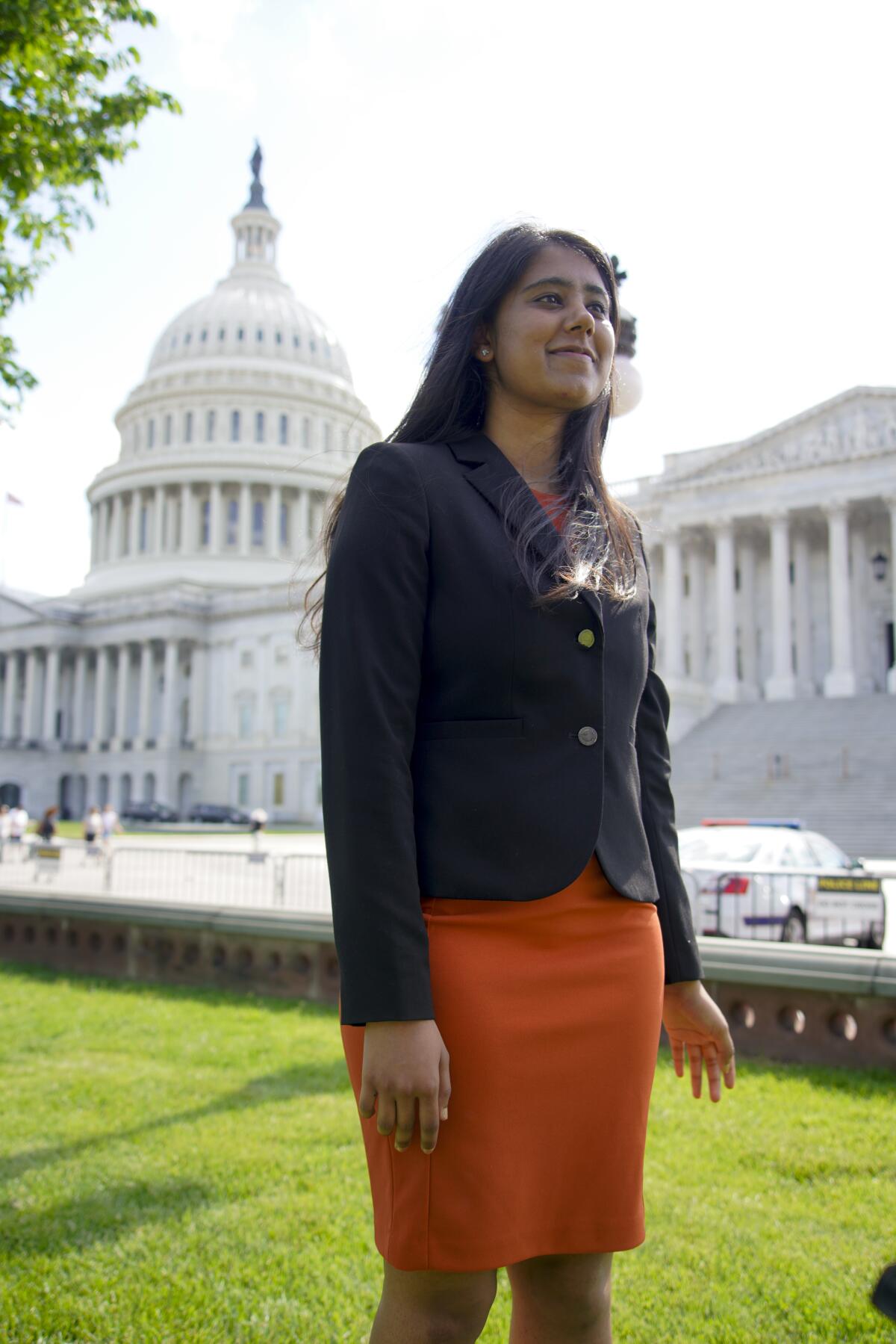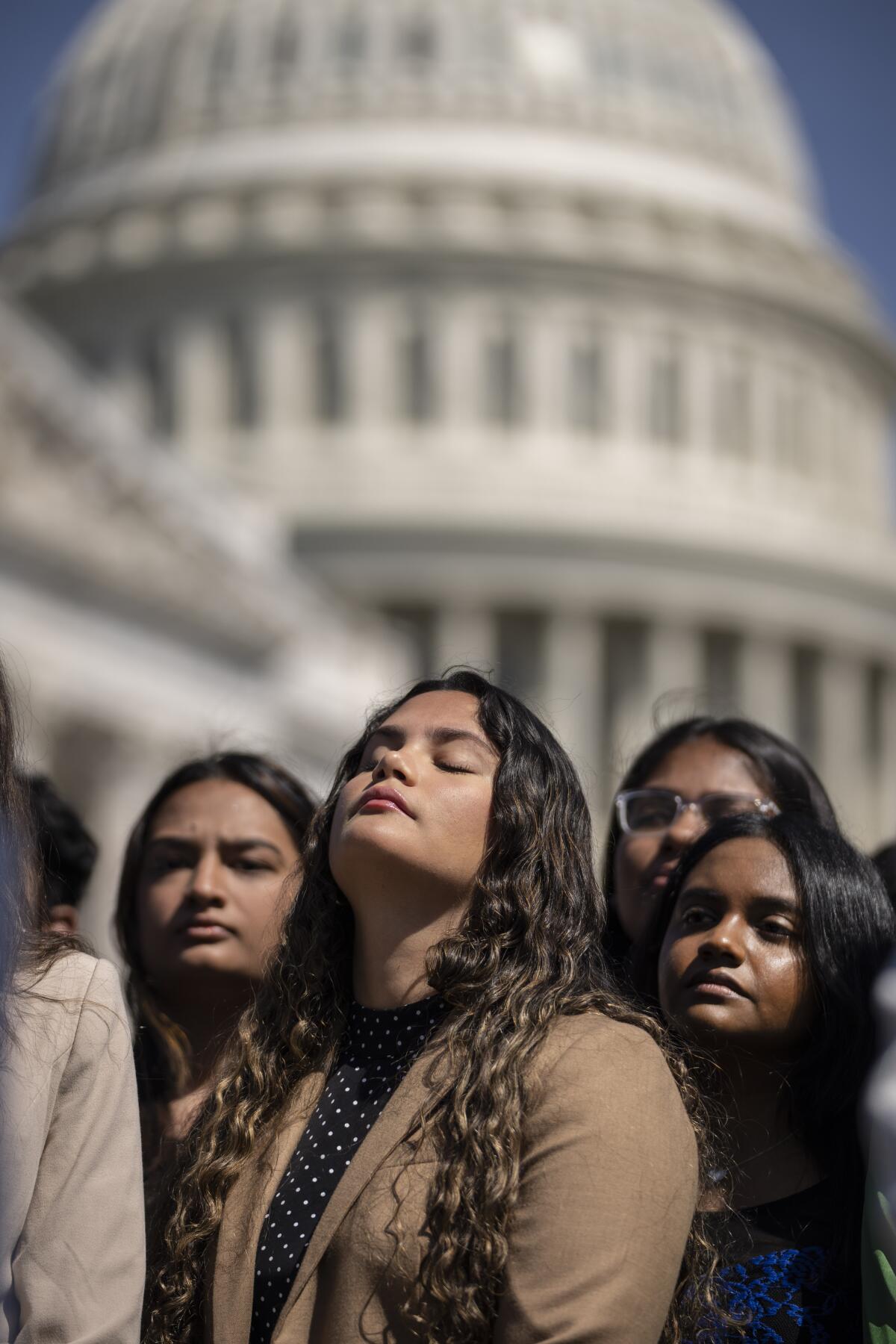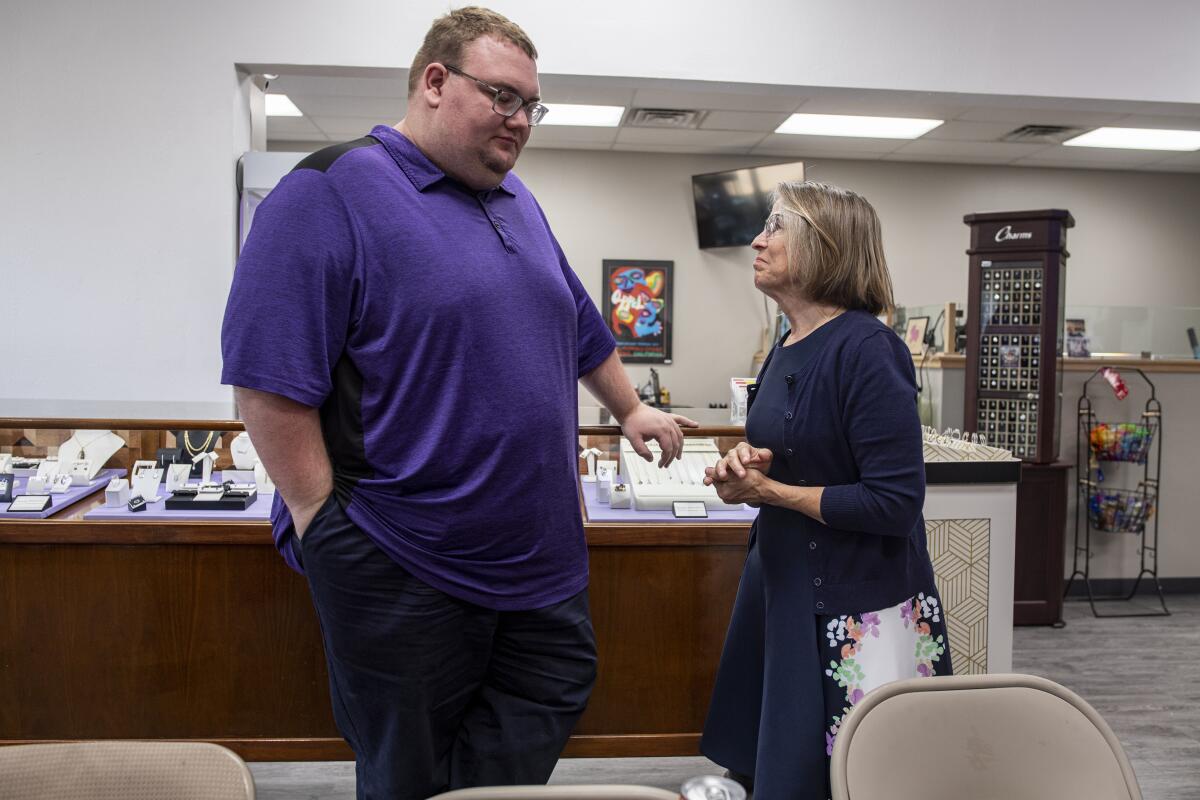Heâs self-deporting after âaging outâ of his parentsâ visa. Will Congress help other immigrants stay?

WASHINGTON â Laurens Van Beek left his parentsâ Iowa City home on Tuesday with three suitcases full of clothes and electronics to board his first international flight in 17 years. He doesnât know when heâll be back.
Van Beek grew up in Iowa but was born in the Netherlands. His parents, who own a small jewelry shop, have renewable work visas. But as of his 21st birthday, just before his senior year at the University of Iowa, he no longer qualified as their dependent.
Van Beek got an international student visa and extended it for three years of postgraduate training. Now 24, heâs a software developer who works in DNA synthesis, But when that clock ran out, so did his ability to legally stay in the U.S. He returned to the Netherlands.
âEverything that we did since coming [to the U.S.] in 2005 has always been by the book,â he said. âI definitely didnât think it would be this difficult.â
More than 250,000 dependent visa holders across the U.S are at risk of leaving the country in which they were raised after âaging outâ of qualifying for lawful status under their parentsâ visas. Thousands have already aged out and have been able to stay under temporary visas or have voluntarily left the country.
Now, after years of advocacy, the so-called documented Dreamers have caught the attention of Congress. Last year, a bipartisan group of lawmakers led by Rep. Deborah K. Ross (D-N.C.) introduced the Americaâs Children Act, which would establish protections to prevent children raised in the U.S. from aging out, provide a pathway to citizenship for them and let people like Van Beek come back.

Documented Dreamers are among the few immigrant groups to receive support of both Republicans and Democrats at a time when immigration policy has become so contentious that nearly any attempt at reform is unlikely to succeed.
There has long been support for the broader population of immigrants brought to the U.S. as children, including those with protections under the Obama-era Deferred Action for Childhood Arrivals program, or DACA.
Ross pointed to recent advocacy by business leaders that she said has accelerated the call for change. In a letter to the Department of Homeland Security last month, tech giants including Amazon, Google and Twitter said immigrants are key to alleviating critical worker shortages and urged policymakers to help documented Dreamers stay in the U.S.
For the record:
7:20 a.m. July 5, 2022An earlier version of this story said the Americaâs Children Act has passed the House. It could likely pass the House.
That need to retain people who were trained and educated in the U.S., combined with unity among various immigrant groups, could be the key to reform, Ross said. Her bill probably could pass the House but faces a more difficult battle in the Senate, where immigration legislation lacks public support from enough lawmakers to reach the 60-vote threshold for passage.
âI am cautiously optimistic that it would be included in the Senate package,â she said.

Many work visas are renewable but donât offer a pathway to citizenship. Among those who can apply for permanent residency â usually through sponsorship from a family member or employer â backlogs have become extremely lengthy for people from India, China and other countries. Thatâs because the U.S. limits how many green cards each year go to people from any given country. Indian nationals with professional degrees who have certain employment-based visas face an estimated lifetime wait.
Advocates say aging out primarily affects the children of Indian visa holders, an estimate based on federal data showing they represent a majority of the child green card backlog. The largest share lives in California.
Reet Mishra, an incoming senior at UC Berkeley, was born in India and moved to Sunnyvale, Calif., at age 8 with her parents and younger sister.

When Mishraâs family applied for green cards, their âpriority dateâ â the date the federal government received the application â was July 2014. Every month they checked the State Department website to see whether they had made it to the front of the queue.
Before Mishra turned 21 in February, the website showed that green cards were available for people with priority dates up to January 2014. Then an overwhelming number of applications caused a bottleneck, and the federal government moved the line back to serve people with priority dates in 2012.
Mishra has now aged out of qualifying to become a permanent U.S. resident under her parentsâ application. She switched to a student visa to continue her studies in bioengineering, electrical engineering and computer science. She plans to get a doctorate degree and dreams of working in medical diagnostics.
But the day in April that Mishra got her new visa was bittersweet.
âI was overjoyed at the fact that I could at least stay here longer,â she said. âBut it was a little sad because it kind of put the nail in the coffin that my future is set on this path that is so uncertain now.â
Dip Patel was also born in India. At age 4, he moved with his parents to Canada, where they became citizens. Several years later, the family moved to the U.S., where his parents opened a convenience store in Illinois under E-2 work visas, which are available to immigrants from 81 participating treaty countries, including Canada. Now 26, he works as a pharmacist for a rural health system in Illinois under a work visa for Canadian professionals.
For five years, Patel has spent his free time trying to help people who grew up in similar situations. Frustrated that no one seemed to understand the difficulty he faced navigating the visa process, he researched how to advocate for himself and others.
He called congressional offices and attended events at which members would be present. He educated immigrant advocacy organizations on the issue of aging out.
Lawmakers initially didnât have answers to his questions. One said he was focused on helping DACA recipients and couldnât help Patel.
âI was trying to explain to him how weâre all in the same boat,â Patel said, recalling that conversation. âIâm trying to show that thereâs broken parts of the system, and you guys are addressing them, but youâre ignoring obvious flaws.â
Patel started a formal group to support and advocate for documented Dreamers, calling it Improve the Dream. He was surprised by the response â thousands of young adults on the cusp of aging out or who already had.
In 2019, during a pharmacy school rotation near Washington, D.C., Patel fought for documented Dreamer protections in the Dream and Promise Act, intended to provide a path to citizenship for people illegally brought to the U.S. as children. But House Democrats voted against an amendment to allow the children of certain holders of work visas to apply for green cards.
The Dream and Promise Act of 2021, should it be passed by Congress, does include documented Dreamers. Even so, Patel noted that it wouldnât fix the root cause of aging out. At least 104,000 young adults will age out of their visas over the next two decades, according to the Cato Institute, a libertarian think tank in Washington,.
âItâs a one-time solution,â Patel said. âWithout a fix to aging out, thereâs going to be more people either becoming undocumented or being forced to leave.â
In high school, Patel had considered himself a âDreamer,â a moniker for immigrants who would have benefited from the legalization measures in the failed Dream Act, which came five votes shy of passing the Senate in 2010. When President Obama announced DACA in 2012, the original memo on the program didnât make clear that people must lack lawful immigration status to qualify. Patel and others in his position werenât eligible.
âWhen there are talks about comprehensive immigration reform, thereâs this rhetoric about just getting into line,â Patel said. âThe truth is, there is no line. Weâre perfect examples of, âOK, show us what exactly we should have done instead.ââ
Patel worked with David Bier, associate director of immigration studies at the Cato Institute, to put together the framework for what became the Americaâs Children Act. Since the bill was introduced, Patel and other members of Improve the Dream have made several visits to Washington.

One of the trips was for a Senate hearing in March on removing barriers to legal migration. Athulya Rajakumar, a 23-year-old Dallas resident who was born in India, gave emotional testimony about her brotherâs death by suicide after the uncertainty of his immigration status contributed to severe mental health issues. Now Rajakumar faces leaving her mother alone in the U.S. when her visa expires this year.
Over the last several months, the Senate bill has gained some bipartisan support, with five Republican co-sponsors.
Bier has been advocating for young people who age out of their parentsâ visas since Obamaâs presidency. After the possibility of comprehensive immigration reform was ruled out and the conversation turned to assisting Dreamers, Bier said he pointed out to congressional leaders that legislation at the time excluded those aging out of visas.
âThis is one of many issues in the immigration space where Congress just didnât have the vision to see a future where the backlog is unbelievable,â he said.
Political analysts were encouraged by the recent passage of bipartisan gun legislation in Congress. Theresa Cardinal Brown, managing director of immigration policy at the Bipartisan Policy Center, said sheâs not sure whether that kind of momentum will translate to breaking the political impasse on immigration.
Brown said itâs unlikely that a solution for documented Dreamers would pass on its own, without Congress simultaneously addressing other issues, including DACA, border enforcement, asylum and immigrants in STEM (Science, technology, engineering, and mathematics) careers.
âOn gun control, itâs what policies will have the largest effect. On immigration, itâs which people get to stay and who is left out,â she said. âThatâs a major differentiator. Is it better to get something for some people than nothing for anybody?â
But Brown said the urgency of the situation for DACA recipients could propel some movement on immigration reform. DACA is hanging by a thread â on Wednesday the U.S. 5th Circuit Court of Appeals in Louisiana is set to hear oral arguments in a case that will decide whether such an expansive program is lawful.

Van Beek, the software developer from Iowa, said he and his parents initially didnât realize that their work visas did not afford them a pathway to citizenship. He started paying more attention to his immigration status as he got closer to 21.
Twice, he attempted to apply for an H-1B visa for people with specialty occupations. But the program is competitive; this fiscal year, 484,000 people registered to apply for just 85,000 visas.
Van Beek is looking forward to spending time with the extended family he grew up seeing only on video calls. Citizenship in the Netherlands allows him to live in Belgium, where his company has an office.
The company is trying to get him an EB-3 visa for skilled workers. In the meantime, he can visit his parents occasionally but doesnât know whether he can permanently come back.
Van Beek is frustrated about how impenetrable the immigration system can be. But heâs also been heartened by the support of his company and friends, who have been calling their representatives to advocate for immigration reform.
âItâs not just about border politics,â he said. âItâs also just about people: Kids and young adults like myself who grew up here from young ages are essentially American in every way but the piece of paper.â
More to Read
Sign up for Essential California
The most important California stories and recommendations in your inbox every morning.
You may occasionally receive promotional content from the Los Angeles Times.
![[20060326 (LA/A20) -- STATING THE CASE: Marchers organized by unions, religious organizations and immigrants rights groups carry signs and chant in downtown L.A. "People are really upset that all the work they do, everything that they give to this nation, is ignored," said Angelica Salas of the Coalition of Humane Immigrant Rights. -- PHOTOGRAPHER: Photographs by Gina Ferazzi The Los Angeles Times] *** [Ferazzi, Gina -- - 109170.ME.0325.rights.12.GMF- Gina Ferazzi/Los Angeles Times - Thousands of protesters march to city hall in downtown Los Angeles Saturday, March 25, 2006. They are protesting against House-passed HR 4437, an anti-immigration bill that opponents say will criminalize millions of immigrant families and anyone who comes into contact with them.]](https://ca-times.brightspotcdn.com/dims4/default/d699c9b/2147483647/strip/true/crop/1977x1322+112+0/resize/320x214!/quality/75/?url=https%3A%2F%2Fcalifornia-times-brightspot.s3.amazonaws.com%2Fzbk%2Fdamlat_images%2FLA%2FLA_PHOTO_ARCHIVE%2FSDOCS%2854%29%2Fkx3lslnc.JPG)










